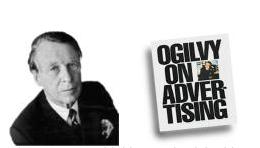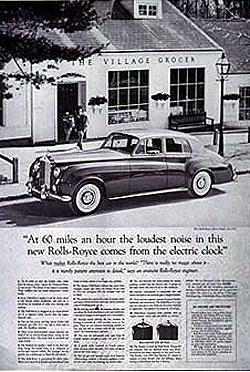David Ogilvy: A profile of the ‘father of advertising’
While the thought of another ‘must read’ book for fundraisers might overwhelm, you really should read this book, especially if you want to hire, or are currently working with an agency, want to apply for a job, have to write copy or are using …
- Written by
- Christiana Stergiou
- Added
- June 03, 2012
A wizard more sought-after than Gandalf. With good reason.

Time magazine called David Ogilvy ‘the most sought-after-wizard in the advertising business’. You’ll find hundreds of websites dedicated to his work, web pages filled with his quotable quotes and videos of the great man on YouTube. You’ll also find thousands of advertisers, young and old alike, who’ll gladly confess to worshipping David Ogilvy as their master.
However, you’ll find few fundraisers who say the advertising genius has greatly influenced them. As a young fundraiser it never occurred to me to read or find out about David Ogilvy, but now, with a good dozen years under my belt, I realise what I’ve missed.

Thankfully, some of the best fundraisers in the world do see Ogilvy as having a significant influence on their careers; great fundraisers like Ken Burnett, author of Relationship Fundraising and Friends for Life. You’ll find Ken’s observations on the singular debt he owes David Ogilvy in the short editorial that accompanies this piece.
‘I prefer the discipline of knowledge to the chaos of ignorance.’ It’s one Ogilvy’s many famous one-liners. And right there, the parallels with fundraising begin.
‘I cannot think of another profession which gets by on such a small corpus of knowledge,’ Ogilvy says.
I can, Mr Ogilvy. I think you, dear reader, can too.
I meet with so many board members, trustees and fundraisers who are looking to raise more money for their cause. Many have built their fundraising on instinct, goodwill and hope, but these things alone will not result in the funds they need to sustain and grow their organisation.
As I started reading Ogilvy on Advertising, I was reminded of Mal Warwick’s book, Fundraising When Money is Tight (Jossey-Bass, USA, 2009). Mal tells the story of two brilliant and powerful princes vying for supremacy in the advertising kingdom: Bill, the Prince of Creativity and David, the Prince of Benefits. Mal is referring to Bill Bernbach, co-founder of advertising agency Doyle Dane Bernbach and the Prince of Benefits is none other than David Ogilvy.
Mal compares Bernbach’s ad for Volkswagen, which focuses on the wonderful car and the terrific company that makes it, with Ogilvy’s ad for Rolls-Royce. Ogilvy’s looks at the genuine benefits of driving a Rolls: ‘At 60 miles an hour the loudest noise in this new Rolls-Royce comes from the electric clock.’ (Both of these ads can be seen in Ogilvy on Advertising, as well as inFundraising when Money is Tight)
Mal argues that the clash between the Bernbach and Ogilvy approaches to advertising has its parallel in nonprofit marketing and fundraising (particularly in direct marketing).
Mal is convinced that the Bernbach school has won. And I have to agree. It’s disappointing that nonprofits look to ‘the creative’ as a panacea. Perhaps they think a clever or witty ad campaign will win them broad pubic support? It very rarely works like that. Often these campaigns, quite simply, don’t raise money.
Ogilvy, always willing to refer to other greats of the advertising world, quotes Benton and Bowles, an agency whose motto was ‘if it doesn’t sell, it isn’t creative.’ And he quotes Rosser Reeves of the Ted Bates agency:
'… now, what do you want out of me? Fine writing? Do you want masterpieces? Do you want glowing things that can be framed by copywriters? Or do you want to see the goddamned sales curve stop moving down and start moving up?’
If you’re working for a nonprofit, which saves lives and changes the world, I reckon you’ve got a moral obligation to focus on that sales curve going up. That rising curve be seen as net income – money that you can spend on your cause.
Ogilvy says he hates rules, yet for him rules are important so that advertisers and their clients don’t make the same mistakes again and again. And if you want to break the rules, then you should test against them. By following the many rules in this book, drawn from one of the world’s greatest advertising minds, fundraisers can achieve so much more for their cause.
Ogilvy’s experience with the simple design tactic of reverse type is an excellent illustration.
He says, ‘Advertising agencies waste their client’s money repeating the same mistakes. I recently counted 49 advertisements set in reverse type (white type on black background) in one issue of a magazine, long years after research demonstrated that reverse is difficult to read.’
Reverse type is tempting for designers and fundraisers alike. In fact, we’ve showcased a reverse type press ad by Greenpeace here on SOFII. (We think it was a laugh!) But when Save the Children followed David Ogilvy’s advice to change their press ad from reverse copy to black type on a white background, they raised twice as much money.
Some of the most effective fundraising can be turned down as being not ‘creative’ enough. Long letters and long headlines are often brushed aside with, ‘I wouldn’t read a letter that long’. But David Ogilvy knows better. He has found that long wins almost every time. His press ad for the World Wildlife Fund is a remarkable 3,232 words. ‘Only amateurs write short copy,’ he says.
His general copy tactics are ones that all fundraisers should heed. Long copy, long headlines, address people as individuals, use plain conversational language and write your copy in the form of a story.
His more general advertising tips are also important for nonprofits and their fundraisers. While many causes seek a celebrity to promote their cause, Ogilvy recommends avoiding this trap: they will be remembered, but your cause won’t.
And on research Ogilvy says that recall and sales do not correlate. His chapter on the pitfalls and benefits of research is filled with sound advice for those nonprofits that ‘hope’ their advertising campaign will result in funds. It’s effective fundraising (particularly direct marketing) that is going to help you, not a clever commercial or billboard. Ogilvy’s first job in the USA was with George Gallup’s Audience Research Institute and his pragmatic approach to research is one from which all fundraisers can learn.
And what’s a review about Ogilvy on Advertising without talking about what he calls ‘direct mail, my first love and secret weapon’? Advertisers often have difficulty in working out the results (or funds raised) from ad campaigns. Direct marketers ‘can measure the result of every mailing to the dollar.’
And let me leave you with one more gem from the wizard of advertising.
‘I once asked Sir Hugh Rigby, surgeon to King George V, “What makes a great surgeon?” Sir Hugh replied, “There isn’t much to choose between surgeons in manual dexterity. What distinguishes the great surgeon is that he knows more than other surgeons.” It is the same with advertising agents. The good ones know more.'
It’s the same with fundraisers.
Christiana Stergiou is an accomplished fundraiser, has her own fundraising consultancy, Scribbly Bark and you can contact her at christiana@scribblybark.com.au.
See also A debt to the master: the Ogilvy effect here
© Christina Stergiou 2012.

















